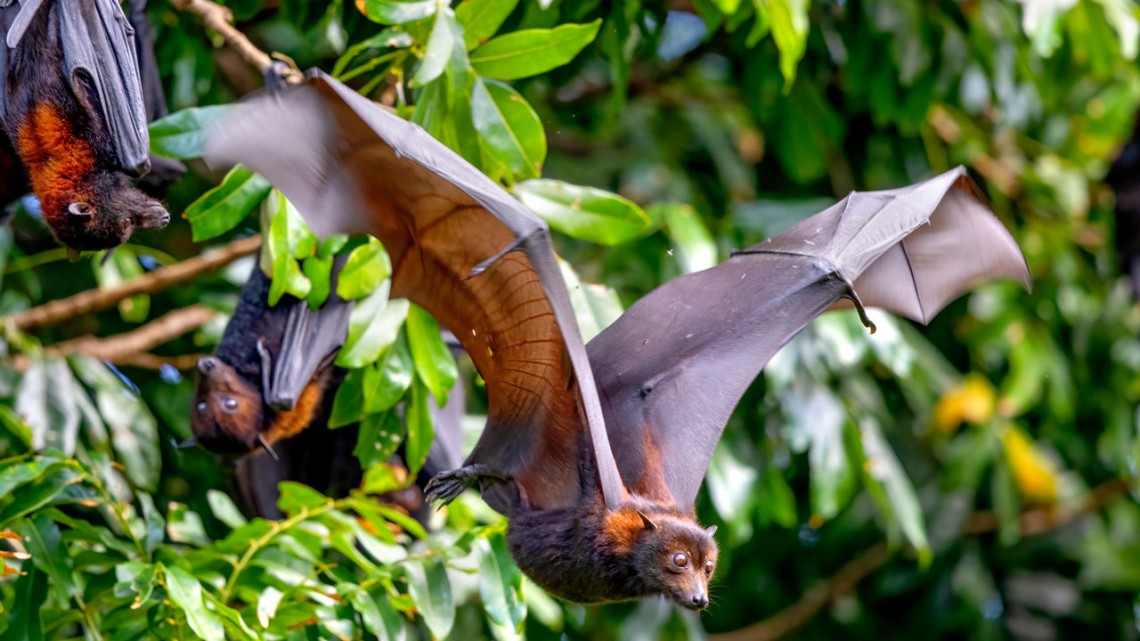
Black flying fox (Pteropus alecto)
Protect habitat to prevent pandemics
By Krishna Ramanujan, Cornell Chronicle
While world public health agencies are focused on how to react to the next pandemic once it has started, a new plan proposes using ecological perspectives to prevent disease outbreaks before they happen, according to a paper published March 26 in Nature Communications.
Pandemics begin when disease-harboring animals, such as bats, come in close proximity with people, livestock or other animals and pass on new pathogens. Viruses such as SARS-CoV-2, SARS-CoV-1, Nipah, Hendra and possibly Ebola have all fatally spilled over from bats to humans, sometimes through an intermediate host.
An international team of 25 scientists led by a Cornell expert has proposed a roadmap for how to prevent the next pandemic by conserving natural areas and promoting biodiversity, thereby providing animals with enough food, safe havens and distance to limit contact and transfer of pathogens to humans.
“The world is focused on how can we detect and then contain a novel pathogen once it is circulating in humans, rather than how can we prevent that pathogen from entering the human population in the first place,” said Raina Plowright, professor in the Department of Public and Ecosystem Health in the College of Veterinary Medicine, and first author of the paper, “Ecological Countermeasures to Prevent Pathogen Spillover and Subsequent Pandemics.”
“Pandemic prevention promotes health equity by reducing the risk that a pandemic will happen, reducing disease risk for everyone," said Charley Willison, assistant professor of public and ecosystem health and a co-author on the paper.
The pandemic-prevention strategy is based on insights from a pair of 2022 papers that serve as a case study applicable to all animals that potentially carry zoonotic diseases. Those papers – about how bats can spread fatal Hendra virus to horses and people – explained that when bats lose their natural habitats and winter food sources, their large populations splinter and they migrate in small groups to agricultural and urban areas. They also become stressed, partly due to inadequate food sources, and they shed more virus in their urine. The virus falls to the ground where grazing horses become infected; horses in turn can then infect people. But when natural habitats can provide adequate food, especially in fallow winter months, the bats return to these habitats, aggregate in large numbers, and stop shedding virus.
The roadmap uses this and other case studies to explain the mechanisms linking environmental change and spillover of pathogens from animals to humans, and identifies ecological interventions to disrupt these links and policy frameworks to implement them.
Land-use changes are a prominent driver for pathogen spillover into people from wildlife, through human behaviors that put people in closer contact with animals. For example, when humans build roads into previously intact natural areas it increases opportunities for human exposure with wildlife species. With deeper access to natural areas, wildlife trade increases, new industries such as bat guano mining in caves open up and new communities may hunt more, often in order to subsist. People have contracted disease from butchering bats or eating fruit contaminated with bat saliva.
Also, as the Hendra virus case study revealed, without intact habitat, animals become stressed and shed more virus, and they move in search of food towards agricultural and urban areas, overlapping more with people. Many experts believe the next pandemic will come from a new pathogen that has yet to infect people, Plowright said.
Ecological interventions that disrupt these mechanisms for spillover begin by protecting the places where animals eat. “We need to make sure there’s always an abundant supply of food available at all times of year, especially when animals are in stressful life history stages like reproduction and migration,” Plowright said.
Next, it’s important to protect where animals may roost or aggregate, as tens of thousands of bats can roost in canopies and caves, so when these areas are disturbed, these populations can splinter, move and shed more virus. Also, cave dwelling bats may not have other caves to move to, in which case they stay put, become more stressed and likely shed more virus. Protecting lands that act as buffers between people and wildlife is also key.
“There are trillions of microbes in nature, but we rarely actually get sick, because there are many, many barriers between us and new pathogens,” Plowright said.
Lastly, for communities who come in contact with animals, it’s important to ensure people have the protection that they need to avoid pathogen exposure, Plowright said.
The researchers propose solutions that not only protect humanity from the next pandemic, but also conserve biodiversity and mitigate climate change; they argue that policy frameworks should try and reflect these synergies. While public health officials have focused on biomedical research, which is necessary, Plowright said, only a handful of ecological studies exist that explore drivers of spillover and what stops it.
The study’s authors emphasize the need for an international agency or panel that can assess and synthesize data on pandemic prevention, preparedness and response and collect metrics on intactness of landscapes, ecological integrity and biodiversity.
“Limited policy capacity paired with the increased risk of pandemics due to climate change necessitates action,” Willison said. “Greater investment in pandemic policies overall, with an emphasis on pandemic prevention, will promote more effective and equitable pandemic mitigation strategies."
Co-authors hail from the London School of Hygiene and Tropical Medicine, University of Oxford, Muni University in Uganda, Bat Conservation International, Kerala Agricultural University in India, the American Museum of Natural History, the University of Benin in Nigeria, Conservation International and many more.
The paper was funded by the Cornell Center for Pandemic Prevention, Preparedness and Response, the National Science Foundation, the Defense Advanced Research Projects Agency, the National Institutes of Health, the Montpellier Advanced Knowledge Institute on Transitions and the National Environment Research Council.
Media Contact
Get Cornell news delivered right to your inbox.
Subscribe
